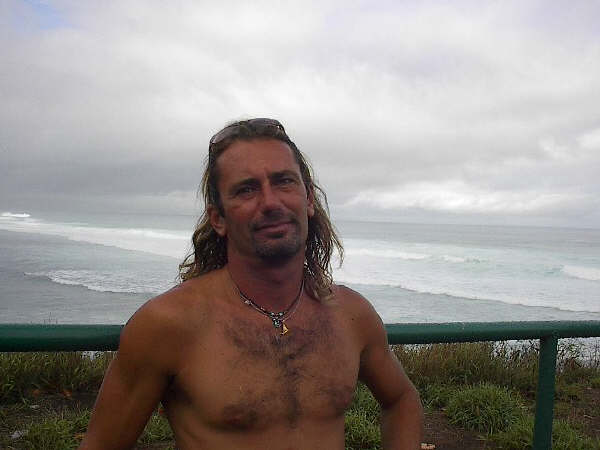Below is the shadow line for Honolua that sits at 335 degrees. Anything more west than that, will have to bend around Molokai to hit the bay. The bigger the size and the higher the period, the more that will happen.
I also drew some lines representing a swell coming from 360 instead to show how it will travel unrefracted till the bay and then, if it's big enough, start bending around the coast line. If a straight north swell is big enough, the wrap will be felt all the way down to Puamana. Same can happen for swells coming from the NE quadrant, as long as they are big/long period enough.
And if a swell from 335 or even more west than that is big/long period enough, you can imagine it doing an S turn: first refracting on Molokai and changing its direction to more straight north and then refracting on west Maui and changing its direction to more west again. All this, of course, happens to the expense of the energy of the swell, but it's pretty amazing that waves can do that.
Below are the 6am readings and graphs of the three buoys.
I pointed out the peaks to show how nicely the travelling time predictions outlined in that Surfline article (and my Maui extension of it) have been correct.
The swell peaked at around 10f 12s around 8am at the NW buoy.
It peaked at around 6f 12s around midnight (16h later).
It's peaking at around 6f 12s around 6am in Maui (22h later).
Hour more hour less, we got this one right. What really perplexes me is that last 6f 12s reading in Maui. It seems like a glitch, since the previous 5am reading was indicating only 10f 10s of windswell.
I don't exactly know how surfline breaks down the different swell hitting a buoy. They use the raw data that the buoy collects and in this there's info about the amount of energy contained in each different period. In this case windswell and WNW swell have similar periods (10 and 12), so it might be a bit confusioning for the extrapolating algorithm.
But we never want to get too detailed. Once again, all these considerations are full of approximations.
It also seems that Mr. Warren was right with the size decay. 50-70% he said for a swell from WNW refracted by Kaui from the NW buoy to Waimea and 6f is right in that range. But the swell size would have diminished anyway even without refraction (just because of the travelling), so in this case I'll blame the refraction over Kauai for the loss of a couple of feet and the travel time for another two feet. As a matter of fact, the swell peaked in Kauai at around 8f 12s.
Next thing you guys need to notice on the graphs is how the direction veered to a more northerly angle (lines in the lower part of the graph). That means less blockage for Maui, so today it should be bigger than yesterday here.

Hookipa wasn't all that big in fact yesterday (while Haleiwa had occasional double overhead sets), I went there for the sunset and took these shots of the 2015 Aloha Classic champion Morgan Noreaux.
MC2km map at noon shows the wind that it shows. Look at the difference between north shore and lahaina side!
Wind map shows the last bit of the northerly fetch that (in a more WNW position and a couple of days ago) created the actual swell. That means that there will be a couple of extra days of northerly waves. Smaller in size, but less blocked for us.
Here's what Pat Caldwell said yesterday about that fetch, btw:
"Mid Wednesday on northern shores has rising breakers from 300-310 degrees with 12-16 second periods. The WNW component should drop on Thursday as energy from NW to NNW builds.
A surface low pressure crossed the dateline late Sunday 11/15 with an ESE track into Monday 11/16. It took a more NE track 11/17-18. It was unusual compared to most eastward-tracking, mid- latitude lows in that the strongest winds favored the N to W quadrant with highest seas aimed SW toward the marshall islands. The quadrant aimed towards Hawaii was the weakest throughout the life cycle.
During 11/15-16, the fetch aimed at Hawaii was mostly strong to marginal gale winds over the 290-310 degree band. This developed dominant energy with moderate periods of 12-16 seconds. This energy arrived 11/17-18 at the NW Hawaii NOAA buoys 51101 and 51001, the latter of which is 60 nm further north than the historic position, close to 51101. The pacioos/cdip Hanalei, Kauai and Waimea, Oahu buoys show an upward trend in the 12-16 second wave energy Wednesday morning. The NOAA buoys peaked near sunrise and the WNW surf locally should peak after sundown 11/18."
I also pointed out a small fetch south of New Zealand, which energy is probably going to be entirely blocked by it.
And I also put an arrow on a pretty intense fetch of strong winds that is about to move right at the "entrance" of the Tasman Sea and create a big swell for Fiji. Now would be a good time to book a trip there, also because another fetch will do exactly the same thing later next week.
Surfline calls the first one peaking at 8f 15s on Nov 26 and the second one at 6f 15s on Nov 29.
PS. This morning Barbers point doesn't show any sign of the long period south swell forecasted for tomorrow, so that one isn't early and lahaina side is tiny and even a bit onshore at 8am.















No comments:
Post a Comment